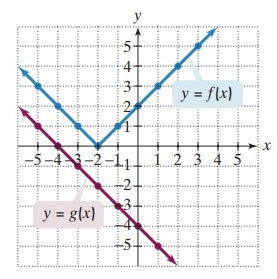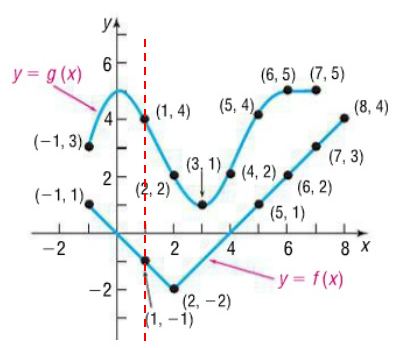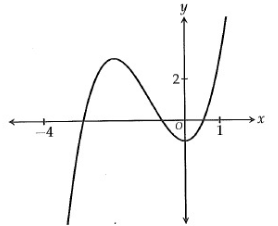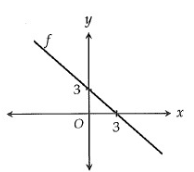EVALUATE THE COMPOSITION OF FUNCTIONS GRAPHICALLY
Subscribe to our ▶️ YouTube channel 🔴 for the latest videos, updates, and tips.
Use the graphs of f and g to evaluate each composite function.

Problem 1 :
(f ∘ g)(-1)
Solution :
From the graphs given above, it is clear that the line is crossing the curve g(x) at -3.

The value of g(-1) is -3.
f(g(-1)) = f(-3)

When x = -3, the vertical line crosses the curve f(-3) at 1.
f(g(-1)) = 1
Problem 2 :
(f ∘ g)(1)
Solution:
From the graphs given above, it is clear that the line is crossing the curve g(x) at -5.

The value of g(1) is -5.
f(g(1)) = f(-5)

When x = -5, the vertical line crosses the curve f(-5) at 3.
f(g(1)) = 3
Problem 3 :
(g ∘ f)(0)
Solution:
(g ∘ f)(0) = g[f(0)]
= g(2)
g[f(0)]= -6
Problem 4 :
(g ∘ f)(-1)
Solution:
(g ∘ f)(-1) = g[f(-1)]
= g(1)
g[f(-1)]= -5
Problem 5 :
Use the graphs to evaluate the composition of functions.

a) (g ∘ f)(1) b) (g ∘ f)(5) c) (f ∘ g)(0) d) (f ∘ g)(2)
Solution:
a) (g ∘ f)(1)
From the graphs given above, it is clear that the line is crossing the curve f(x) at -1.

The value of f(1) is -1.
g(f(1)) = g(-1)

When x = -1, the vertical line crosses the curve g(-1) at 3.
g(f(1)) = 3
b) (g ∘ f)(5)
Solution:
From the graphs given above, it is clear that the line is crossing the curve f(x) at 1.

The value of f(5) is 1.
g(f(5)) = g(1)

When x = 1, the vertical line crosses the curve g(1) at 4.
g(f(5)) = 4
c) (f ∘ g)(0)
Solution:
(f ∘ g)(0) = f[g(0)]
= f(5)
f[g(0)]= 1
d) (f ∘ g)(2)
Solution:
(f ∘ g)(2) = f[g(2)]
= f(2)
f[g(2)]= -2
Problem 6 :

Four values for the functions f and g are shown in the table above. If g(m) = 6, what is the value of f(m) ?
Solution:
g(m) = 6
For what value of m, we find the value 6 in the function g(x).
m = 3
f(x) = f(3)
f(3) = 5
f(m) = f(3) = 5
Problem 7 :

The function f is graphed in the xy-plane above. If f(c) = f(3), which of the following could be the value of c?
A) -3 B) -2 C) -1 D) 2
Solution:
From the given graph,
We have, f(c) = f(3)
f(3) = 2 (From the graph)
f(-1) = 2
f(3) = f(-1)
c = -1
So, option (C) is correct.
Problem 8 :

The graph of the function f in the xy-plane is shown above. For how many values of x in the portion of the graph shown above does f(x) = 2 ?
A) None B) One C) Two D) Three
Solution:
Given, f(x) = 2 or y = 2

The horizontal line drawn at the point y = 2 crosses the curve at 3 places.
Hence, number of x value is three.
So, option (D) is correct.
Problem 9 :

The function f is graphed in the xy-plane above. If the function g is defined by g(x) = f(x) + 2, what is the x-intercept of g(x)?
A) -1 B) 0 C) 1 D) 5
Solution:
y = mx + b
Slope m = -3/3
m = -1
f(x) = -x + 3
Adding 2 to get the equation of g(x) = -x + 3 + 2
g(x) = -x + 5
g(x) = 0
-x + 5 = 0
x = 5
So, option (D) is correct.
Problem 10 :
If f(x) = 3x - 1 and 2f(b) = 28, what is the value of f(2b)?
Solution:
Given, f(x) = 3x - 1
2f(b) = 28
x = b
f(b) = 3b - 1
2f(b) = 3b - 1
28 = 2(3b - 1)
28 = 6b - 2
30 = 6b
b = 5
f(2b) = f(2(5)) = f(10)
f(10) = 3(10) - 1
f(10) = 30 - 1 = 29
f(2b) = 29
Problem 11 :
f(x) = x2 - 3x
g(x) = 2x + 14
The functions f and g are defined above. For how many values of k is it rue that f(k) = g(k)?
A) None B) One C) Two D) More than two
Solution:
Given,
f(x) = x2 - 3x
g(x) = 2x + 14
x = k
k2 - 3k = 2k + 14
k2 - 3k - 2k - 14 = 0
k2 - 5k - 14 = 0
(k - 7) (k + 2) = 0
k = 7 or k = -2
k = 7
So, option (D) is correct.
Problem 12 :

The values in the table above define a linear function. What is the value of m + n?
A) -4 B) 0 C) 4 D) 8
Solution:
f(x) = ax + b
f(6) = 6a + b and f(5) = 5a + b
f(6) + f(5) = 6a + b + 5a + b
= 11a + 2b
We know,
f(4) = m and f(7) = n
m = 4a + b, n = 7a + b
m + n = 4a + b + 7a + b
m + n = 11a + 2b
m + n = f(5) + f(6)
f(5) + f(6) = 2 + (-2) = 0
m + n = f(5) + f(6) = 0
So, option (B) is correct.
Problem 13 :
A function f(x) has two properties;
f(a + b) = f(a) - b
f(2) = 10
What is the value of f(5)?
A) 5 B) 7 C) 9 D) 11
Solution:
According to f(2x) = 10
When x = 1
f(2x) = f(2) = 10
When b = 3 and a = 2
f(2 + 3) = f(2) - 3
= 10 - 3
= 7
So, option (B) is correct.
Subscribe to our ▶️ YouTube channel 🔴 for the latest videos, updates, and tips.
Recent Articles
-
Finding Range of Values Inequality Problems
May 21, 24 08:51 PM
Finding Range of Values Inequality Problems -
Solving Two Step Inequality Word Problems
May 21, 24 08:51 AM
Solving Two Step Inequality Word Problems -
Exponential Function Context and Data Modeling
May 20, 24 10:45 PM
Exponential Function Context and Data Modeling